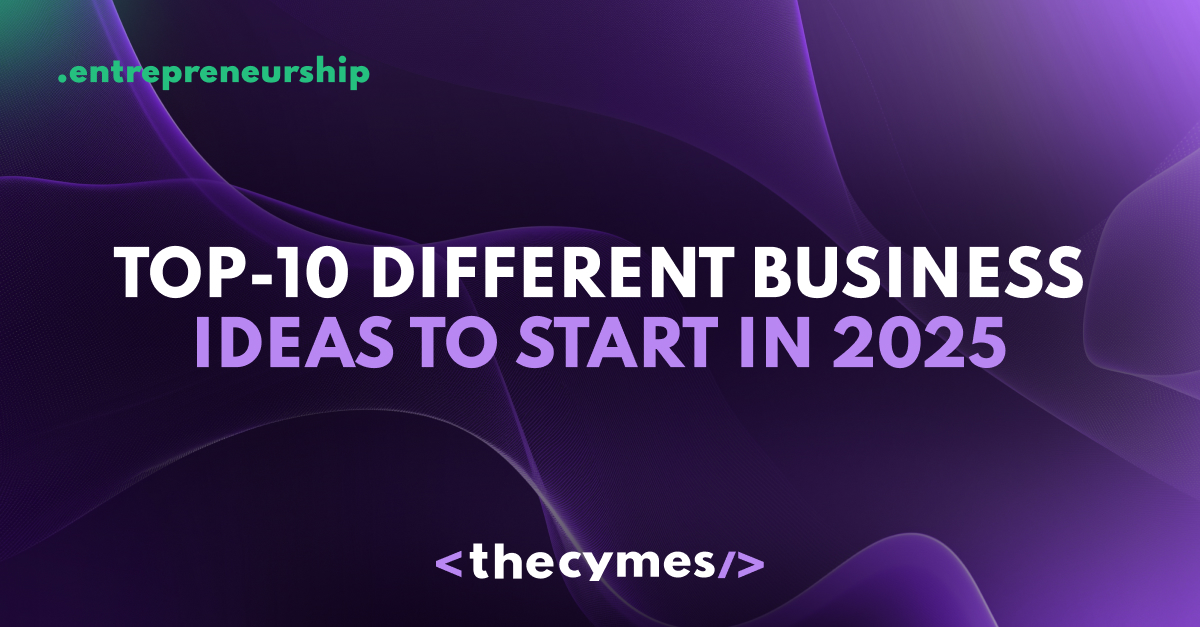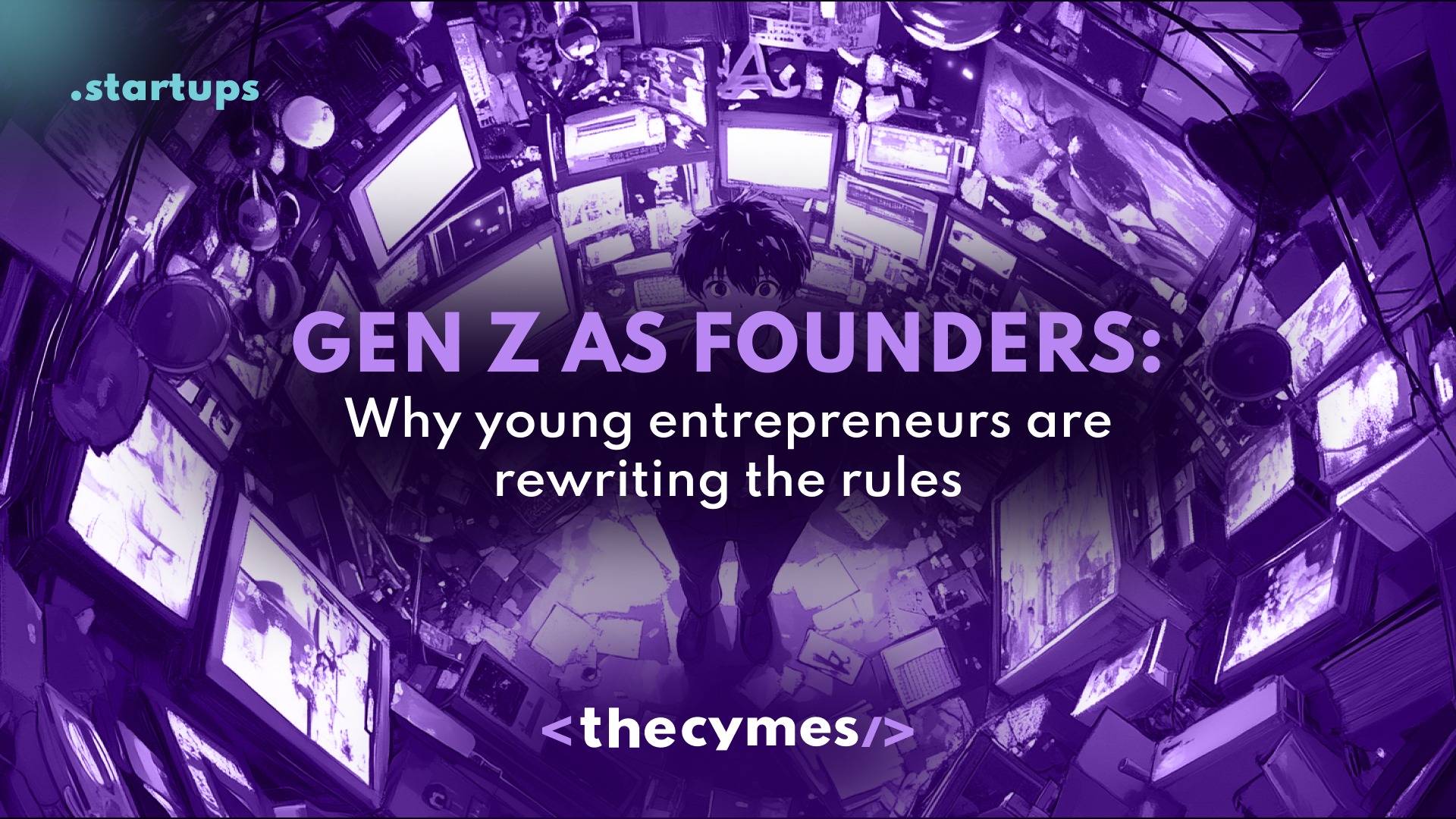Table of Content
TOP-10 different business ideas to start in 2025
/>From AI-driven marketing and online courses to eco-friendly solutions and niche e-commerce, with growth forecasts and market insights to help you choose the right path.Startup ideas for 2025
The time of great change creates space for great opportunities. The year 2025 is of particular interest to entrepreneurs, as the world has finally adapted to the digital reality, and consumers have formed new habits and needs.
The modern market is characterized by several key features. Consumers have become more aware, and they value personalization and convenience. Technology is no longer an end in itself, but rather a tool for solving specific problems. Environmental responsibility has become not just a trend, but a basic market need. Under these conditions, the projects that combine technological advancement with an understanding of real human needs have the best chance of success.
Analyzing current trends and expert forecasts, we can identify the directions that will determine the business landscape of the coming years. Today, we have gathered for you the current ideas, directions that have a stable growth potential. Let's find out more!
1. Online courses and digital educational products
The online education segment will reach $1 trillion by 2030, according to HolonIQ, and that's no exaggeration. The pandemic has changed the perception of remote learning: it is now seen not as a “simplified version of offline”, but as a separate, self-sufficient format.
In 2025, the key growth factor will be AI platforms that allow courses to be created in weeks, not months, and personalize the process for each student. On-demand training is in demand among corporate clients (employee skills development) and individuals who want to quickly master new skills, from data analysis to baking.

Image from Freepik
Regional specifics
- USA/Canada: B2B solutions for corporations dominate, average check $2,000-5,000 per course
- Europe: Focus on compliance training and language courses, GDPR regulation
- Asia: Mass courses on technical skills, low prices ($50-200), high volumes
- CIS: Growing demand for IT courses and entrepreneurship, average check $300-800
Critical risks
- Over-saturation of the market with basic courses
- High customer acquisition costs (up to 40% of revenue)
- Difficulties with retaining students (completion rates often below 15%)
- Technical barriers for older teachers
Practical entry plan
- Month 1-2: Choose a niche (e.g., Excel for accountants), create an MVP on Teachable or Thinkific
- Month 3-4: Launch a pilot course for 20-30 beta testers, collect feedback
- Month 5-6: Scale through organic traffic (SEO, YouTube) and partnerships with professional communities
- Budget: Starting at $3000 (platform, advertising, video equipment)
2. Digital marketing agency with AI tools
The digital marketing market is valued at $740 billion in 2025, and its growth over the next 5 years is projected to be 13–15% annually. The reason is simple: companies of any size are forced to compete online, and those that fail to adapt to new formats (short videos, generative content, interactive advertising) lose customers.
Agencies that implement AI analytics and automation offer clients not just campaigns, but a system of constant growth in traffic and sales. The entry threshold is average, but demand is stable even during crises.
Regional specifics
- USA: Premium segment, clients are willing to pay $10,000-50,000/month for a full cycle
- Europe: Strict requirements for privacy, focus on GDPR-compliant solutions
- Latin America: Fast-growing SMB market, budgets $500-3000/month
- CIS: Performance marketing and e-commerce dominate, with an average budget of $1,000-5,000/month
Critical risks
- High competition and price dumping
- Dependence on changes in platform algorithms (Meta, Google)
- Difficulty in retaining customers (average LTV/CAC = 3:1)
- The need for the team to constantly learn new tools
Practical entry plan
- Month 1: Specialize in a specific industry (e.g., fitness clubs or dentistry)
- Month 2-3: Master 2-3 AI tools (Jasper for content, Adverity for analytics)
- Months 4-6: Find the first 3-5 clients through personal connections, and work on the result
- Budget: $5,000-8,000 for software, training, and initial advertising
3. Repair services for technical and household equipment
The consumer focus on “repair, not throw away” has become not only an ethical but also an economic choice. European countries are already enshrining the "right to repair" in law, which is expected to lead to an increase in orders for small businesses in this area.
By 2030, this market in the US and Europe could grow by 25–30% due to rising prices for new equipment and a reduction in the number of manufacturers willing to offer cheap models.
Regional specifics
- Europe: Legislative support, high prices for services (€50-100/hour)
- USA: Niche market for premium equipment, competition with official services
- Asia: Mass market, low prices, high competition
- CIS: Traditionally strong repair culture, growing demand for mobile services
Critical risks
- Responsibility for the quality of repairs and warranty obligations
- The need for large investments in equipment and spare parts
- Difficulties with finding and training skilled craftsmen
- Competition with officially authorized services
Practical entry plan
- Month 1: Choose a specialization (e.g., only smartphones or only household appliances)
- Months 2-3: Complete training, set up a workshop, and establish a parts supply
- Months 4-6: Launch local advertising, establish partnerships with electronics stores
- Budget: $10,000-15,000 for equipment, rent, and initial spare parts stock
4. Personal services: tutoring and training
Individual instruction and personal fitness are two areas where the emotional component is more important than the price. The consumer is looking for a human relationship and adaptation to their goals.
The personal fitness market is growing amid the wellness boom, and tutoring is being strengthened by the trend toward alternative education (homeschooling, proprietary programs). By 2030, the global tutoring market could exceed $200 billion.
Regional specifics
- North America: High rates ($50-150/hour), focus on results and metrics
- Western Europe: Price-quality balance ($30-80/hour), certification is important
- Eastern Europe: Growing market ($15-40/hour), high competition
- Asia: Mass segment, group formats, technological solutions
Critical risks
- High personal dependence on the coach/instructor
- Difficulties with scaling without losing quality
- Seasonality of demand (especially in fitness)
- The need for constant marketing to attract new customers
Practical entry plan
- Month 1: Define the niche and obtain necessary certifications
- Month 2-3: Create programs, find first clients through social media
- Month 4-6: Scale through recommendations and local presence
- Budget: $2,000-5,000 for certification, equipment, marketing
5. Self-storage and flexible workspaces
Storage units and flexible workspaces have become a business with almost "rental" logic: high predictability of income and long-term contracts. According to Mordor Intelligence, the global self-storage market will grow by 7% annually, reaching $80 billion by 2030.
A special driver is for microbusinesses in e-commerce that need to store goods, but it is not profitable to rent an entire warehouse.

Image from Freepik
Regional specifics
- United States: Mature market, high rental rates ($50-200/m²/month)
- Europe: Developing segment, regulatory restrictions
- Asia: Rapid growth in megacities, shortage of space
- CIS: Niche market, low consumer awareness
Critical risks
- High initial investment in real estate
- Dependence on local demand and economic situation
- Competition with traditional warehouse operators
- Regulatory risks and safety requirements
Practical entry plan
- Months 1-3: Research the local market, find suitable real estate
- Months 4-9: Obtain permits, make repairs, install security systems
- Month 10-12: Launch marketing, attract first customers
- Budget: $50,000-200,000 depending on size and location
6. Eco-friendly solutions: carbon accounting and reusable packaging
Sustainable development is no longer an "optional" item. Major corporations are requiring contractors to provide ESG reporting, which means that even small businesses are looking for partners to calculate their carbon footprint or implement reusable packaging.
According to forecasts, the market for environmental B2B services will double by 2030, and startups in this niche will be able to attract venture capital investments at early stages.
Regional specifics
- Europe: Strict regulation, high demand for reporting
- United States: Corporate initiatives, venture investments
- Asia: Manufacturing focus, export of eco-solutions
- CIS: Early stage, low awareness
Critical risks
- Changes in regulation can both help and harm
- High R&D expenses for materials development
- Consumer skepticism towards "green" marketing
- The need for certification and compliance with standards
Practical entry plan
- Month 1-2: Choose a specific niche (e.g., carbon tracking for restaurants)
- Months 3-6: Develop methodology, obtain necessary certifications
- Month 7-12: Find pilot customers, refine the product
- Budget: $15,000-30,000 for development, certification, pilot projects
7. Co-working and remote work services
The co-working spaces of the future are not just about a desk and Wi-Fi, but multifunctional centers with podcast studios, VR presentation rooms, and food services. The hybrid work format has taken hold, and companies will pay employees for "off-site work" as part of their benefits packages.
The Global Coworking Growth Study predicts that the number of coworking spaces worldwide will double by 2030.
Regional specifics
- North America: High prices ($200-500/month), corporate contracts
- Europe: Government support, focus on community
- Asia: Rapid growth, technological solutions
- CIS: A growing segment, focus on the IT community
Critical risks
- High, ongoing expenses for rent and utilities
- Sensitivity to economic downturns
- Competition with homework and traditional offices
- Difficulties in maintaining an occupancy rate above 80%
Practical entry plan
- Months 1-3: Find a location in a business district, research competitors
- Months 4-8: Complete repairs, purchase equipment, obtain licenses
- Months 9-12: Start soft opening, attract community
- Budget: $30,000-100,000, depending on size and level
8. Concierge services and mobile services
Turn-key services with on-site visits to the client are growing at the intersection of several trends: saving time, growth of megacities, and the habit of delivery "everything at once". In 2025, mobile grooming, dry cleaning with a visit, or a tire change at the business center parking lot will already be perceived as a basic service, not a premium one.
Regional specifics
- United States: Tip-based culture, high rates ($20-50/hour)
- Europe: Labor regulations, average rates
- Asia: Mass market, low prices, high competition
- CIS: Growing demand in large cities, informal economy
Critical risks
- High dependence on the quality of personnel
- Logistical complexities and high transportation costs
- Seasonality of certain types of services
- Competition with traditional service providers
Practical entry plan
- Month 1: Choose one service (e.g., car wash), test it on friends
- Month 2-3: Hire 2-3 contractors, purchase equipment
- Months 4-6: Launch local advertising, create a mobile app
- Budget: $8,000-15,000 for equipment, transportation, and the initial team
9. Event planning and audiovisual production
Events stopped being just a "gathering of people". These are marketing products with digital copies available on social networks. AV production and event planning now go hand in hand: presentations are accompanied by holograms, parties by live broadcasts, and exhibitions by VR tours.
According to Allied Market Research, the event services market is projected to reach $2 trillion by 2030.

Image from Freepik
Regional specifics
- United States: Large corporate events, high budgets ($50,000-500,000)
- Europe: Cultural events, strict safety requirements
- Asia: Mass events, technological innovations
- CIS: Corporate segment, weddings, medium budgets ($5,000-$50,000)
Critical risks
- High dependence on the economic situation
- The need for large upfront investments
- Seasonality and cyclicality of orders
- Responsibility for the safety of participants
Practical entry plan
- Month 1-2: Determine specialization (corporate events, weddings, exhibitions)
- Month 3-4: Create a portfolio, establish connections with contractors
- Month 5-6: Organize the first events, collect feedback
10. Niche e-commerce and eco-fashion
In 2025, consumers will increasingly choose unique products over mass-produced ones. Niche online stores are not only about "things with a story," but also a format in which it's easy to integrate eco-friendly solutions.
Eco-fashion and micro-brands of clothing made from recycled materials will grow by 9–10% per year, outpacing fast fashion.
Regional specifics
- North America: High willingness to pay for sustainability ($100-300 per unit)
- Europe: Strict environmental standards, government support
- Asia: Production base, exports to developed markets
- CIS: Niche premium segment, low awareness of eco-fashion
Critical risks
- High marketing expenses to attract e-commerce
- Difficulties in finding reliable suppliers of eco-materials
- Logistical challenges and high delivery costs
- Competing with fast fashion on price
Practical entry plan
- Month 1-2: Choose a narrow niche (for example, eco-friendly children's clothing)
- Month 3-4: Find a manufacturer, create the first collection
- Month 5-6: Launch an online store, test marketing
- Budget: $15,000-30,000 for the first batch of goods, e-commerce platform, marketing
Forecast through 2030: analytical block
If you break down the prospects by time scale, you can identify several patterns:
Short-term "rockets" (growth in 1–2 years): digital marketing with AI, mobile services, online courses. These niches benefit from the rapid adaptation of technology and low barriers to entry. However, this is where the competition is the highest and the risk of rapid saturation is greatest.
Mid-term "locomotives" (3–5 years): eco-friendly solutions, event AV, niche e-commerce. It's not the speed of the start that matters here, but the right position in the market and stable funding. These areas require time to develop expertise and a client base.
Long-term "infrastructure" projects (5 years): self-storage, coworking. They require large investments and a long payback period, but they provide a stable income stream and are less susceptible to economic shocks.
Critical risk analysis by segment
Technological risks
AI-dependent businesses (online courses, digital marketing) are facing rapid obsolescence of tools. Companies that don't invest at least 15-20% of their profits in R&D risk becoming uncompetitive in 2-3 years.
Regulatory risks
Environmental solutions and personal data in digital marketing are under close scrutiny by regulators. Changes in GDPR, carbon taxation, or reporting requirements could drastically alter the economics of these businesses.
Operational risks
Service businesses (tutoring, concierge services, equipment repair) are extremely dependent on the quality of their staff. High staff turnover (40-60% per year) requires constant investment in hiring and training.
Economic context 2025-2030
Analyzing macroeconomic trends, several key factors that will affect all the presented directions should be taken into account:
Inflation and interest rates: High rates make capital-intensive projects (self-storage, coworking) less attractive to investors, but create advantages for cash-positive businesses with fast payback.
Demographic changes: An aging population in developed countries increases demand for personal services and appliance repair, but reduces the audience for some digital products.
Urbanization: The growth of megacities supports demand for mobile services and coworking spaces, but increases the cost of real estate for physical projects.
Choosing a strategy in uncertain conditions
The year 2025 presents unique opportunities for entrepreneurs, but success will depend not only on choosing the right direction, but also on the ability to adapt to rapidly changing conditions.
Key principles of success:
Focus on unit economics: In an environment of expensive capital, it's more important to create a profitable model at the level of one client than to chase rapid growth.
Technological flexibility: AI and automation should reduce costs, not complicate business processes. Implement technologies in stages, measuring the ROI at each step.
Sustainability as a competitive advantage: Environmental and social responsibility is no longer a marketing gimmick, but a factor in the choice of an increasing number of customers and investors.
Regional adaptation: Global trends require local implementation. What works in Silicon Valley may fail in Eastern Europe, and vice versa.
Given the analysis presented, the most promising models for 2025-2030 will be hybrid models that combine several directions: online courses with concierge support or eco-friendly solutions with digital marketing. It is such projects that can create sustainable competitive advantages and high customer loyalty in the long term.




